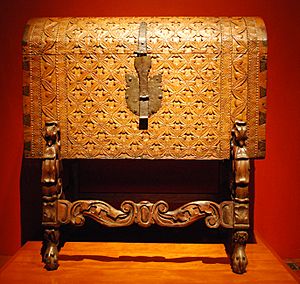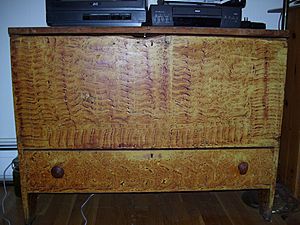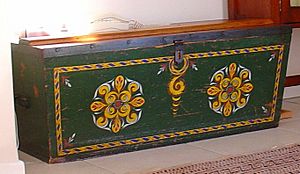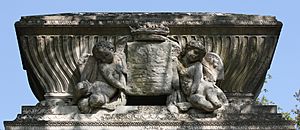Chest (furniture) facts for kids
A chest (also called a coffer or kist) is a type of furniture. It's usually a box with four sides and a lid that opens. People use chests to store things.
Long ago, chests were used to keep important items safe. These included fancy clothes, weapons, food, and valuable treasures.
A special kind of chest from Italy, called a cassone, was often carved or painted. These were sometimes called marriage chests because they held items for a bride's dowry (gifts for her marriage).
Contents
Wakis: Chests on Wheels
In the Cape Colony (a historical area in South Africa), a simple chest called a wakis was often used as a seat on a wagon. It sometimes had a wooden support on top to help the driver stay seated.
People also used wakis chests at home to store clothes, food, and other goods. Many were made from strong woods like yellowwood. Some wakis chests had simple painted designs on the front, similar to styles from Europe.
Chests as Furniture
In Europe during the Middle Ages and early Renaissance, chests had many uses. Low chests were often used as benches. Taller chests could serve as side tables.
Some chests were even used as portable desks. By placing a chest on its side, its lid could become a writing surface. The inside of the chest could hold pens, paper, and other writing tools. The Bargueño desk from Spain is an example of this clever design.
Treasure Chests in Stories
In fantasy stories, fables, and games, "treasure chests" are very common. They are often used to hold exciting things like gold or jewels. Sometimes, finding a treasure chest is a reward for the main character. Other times, the chest itself is important for moving the story forward. A "toy chest" is a type of chest that holds children's toys, like dolls or building blocks.
Chests Around the World
In some Slavic countries, like Ukraine, chests were very important family items, especially for farming families. Each Ukrainian girl received her own chest when she turned 15. This chest was for her future bride's dowry. It was considered rude to look inside a girl's chest. The number of chests a family owned showed how wealthy they were. Ukrainian girls and women also used them to keep their clothes and personal items safe. These items included towels, jewelry, and tools for embroidering. You can see a large collection of traditional Ukrainian chests from the 1700s to 1900s at the Radomysl Castle in the Zhytomyr Region, Ukraine.
In many Arab countries, chests were used to hold a ship captain's personal belongings, like the Kuwaiti chest. Today, many chests from the Middle East are named after the place where they were bought, like "Omani" or "Bahraini" chests. However, this doesn't always mean they were made there.
Other chests are used by girls to collect linens and household goods for their future marriage. These are often called "hope chests." In Arabic, two terms are used for dowry chests. The muqaddimah was specifically for the bride’s personal items. The sunduq, which usually came in matching pairs, held other goods.
Images for kids
-
A chest with a bride's dowry from Kosovo & Metohija, Serbia.
See also
 In Spanish: Arcón para niños
In Spanish: Arcón para niños







